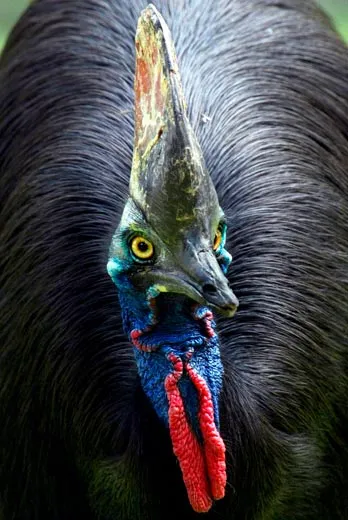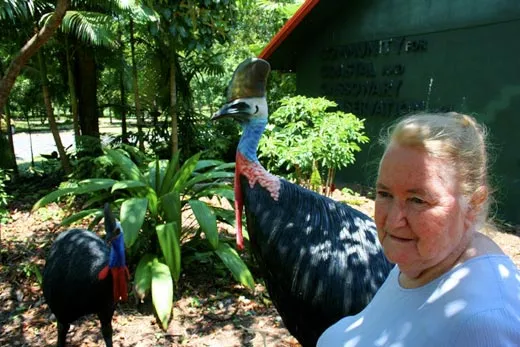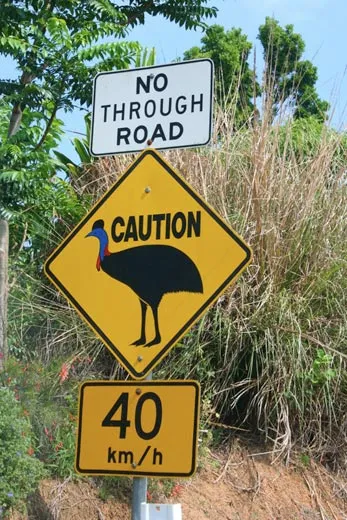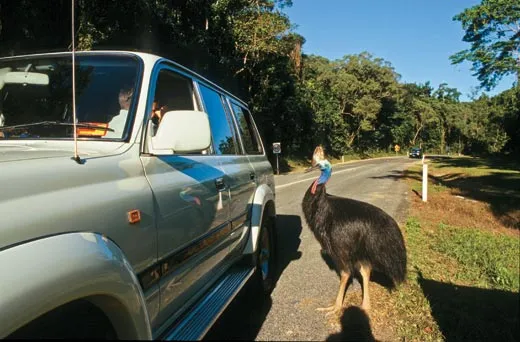Invasion of the Cassowaries
Passions run high in an Australian town: Should the endangered birds be feared—or fed?
/https://tf-cmsv2-smithsonianmag-media.s3.amazonaws.com/filer/cassowaries_oct08_631.jpg)
Ripe fruit plunks to the ground and rolls to the road at my left. That instant, the cassowary bursts from a tangle of ferns outside Clump Mountain National Park near Mission Beach, Australia. The bird's sharp beak is pointed roughly at my neck. Her eyes bulge. She probably weighs about 140 pounds, and as she thumps past me her red wattles swing to and fro and her black feathers give off an almost menacing shimmer. Local residents call her Barbara, but somehow the name doesn't fit the creature in front of me. She looks like a giant, prehistoric turkey—a turkey, however, that could disembowel me with a swipe of its nearly five-inch claws. Luckily, she just wants the mango, which she scoops up whole and mashes with her beak.
Although many of Australia's mammals are, to North Americans anyway, infamous oddballs—from the duck-billed platypus to the eucalyptus-munching koala—the cassowary is gaudy proof that its birds can be just as strange. The southern cassowary is related to the emu and native to the tropical forests of New Guinea and northern Australia. (Two other smaller cassowary species live in New Guinea.) Fewer than 1,500 southern cassowaries live in Australia, where they are endangered; much of their Queensland rain-forest habitat has been cleared for sugar cane and banana plantations.
While programs to protect koalas, which are not an endangered species, draw in millions of dollars in donations, cassowary conservation just squeaks by in the arid continent's last tropical outpost. But the ruggedly independent folk of Queensland feel a bond with their local emblem of biodiversity—everything from stuffed toys to cassowary-themed wind chimes can be purchased along the Cassowary Coast—perhaps out of respect for a flightless creature that's able to eke out an existence despite suffocating heat and devastating storms. And like the cassowaries, Queenslanders have long felt underappreciated; indeed, some urbanites in Sydney and Melbourne refer to them as "banana-benders," as if they have nothing better to do than put the crook in tropical fruit.
But the ornery cassowary is not an easy creature to love. In fact, it ranks as the world's most dangerous bird, at least according to Guinness World Records. A cassowary can charge up to 30 miles an hour and leap more than 3 feet in the air. On each foot are three claws—one slightly curved like a scimitar, the other two straight as daggers—that are so sharp New Guinea tribesmen slide them over spear points. The last person known to have been killed by a cassowary was 16-year-old Phillip McLean, whose throat was punctured on his Queensland ranch in 1926. There have been plenty of close calls since: people have had ribs broken, legs cracked and flesh gashed.
In Mission Beach (pop. 992), two hours south of Cairns, cassowaries have lately come out of the forest, cruising the streets and looking, it seems, for trouble. They peck at bedroom windows, chase cars and tangle with pet terriers.
Townspeople are divided over what to do about the invasion. Many want the birds back in the forest. But others enjoy feeding them, even though that's against the law. They claim that the birds need the handouts: a 15-year drought, a building boom and Cyclone Larry in 2006 wiped out many of the area's native fruit trees, which were prime cassowary food. One woman told me she spends $20 per week on bananas and watermelons for a pair of local birds named Romeo and Mario. "I feed them," she said. "I always have and I always will."
Biologists say she's not doing the birds a favor. "A fed bird is a dead bird," the Queensland Parks and Wildlife Service insists on posters and brochures, underscoring the idea that luring the birds into town endangers them. Since the cyclone, some 20 cassowaries, out of a local population of perhaps 100, have died after being hit by cars or attacked by dogs. Wildlife wardens—clad in chain-saw chaps and groin protectors and wielding giant nets—regularly transport problem cassowaries to more suitable habitat.
To see how life in the cul-de-sacs of Mission Beach has affected the largest native land animal in northern Australia, I visited the Garners Beach cassowary rehabilitation facility five miles north of town. Steve Garrad, a conservation officer for the Australian Rainforest Foundation, was wearing a dirt-streaked khaki outfit and a pair of gaiters to ward off the region's infernal leeches. We entered a pen where a knee-high cassowary chick was zipping along like a teenager on a skateboard. Rocky had been plucked from a dog's mouth in South Mission Beach a few months earlier. Cassowary chicks are striped for camouflage, and Rocky seemed to vanish in the shady enclosure. We finally cornered him near an artificial pond. "It'll lose those stripes in three months' time," Garrad said, "and become a pretty ugly-looking mousy brown." In about a year, Rocky will burst into his adult colors and develop wattles and the species' most remarkable feature: the casque atop its head.
It's an odd structure, neither horn nor bone; it has a hard covering but is spongy inside and somewhat flexible overall. Some researchers have speculated that cassowaries use the strange protuberance as a crash helmet to deflect thick foliage while running through the jungle, or perhaps as a weapon for settling territorial disputes. Ornithologists in New Guinea have proposed another function: amplifier. They reported seeing cassowaries inflate their necks, vibrate their bodies and emit a pulsing boom that drops below the threshold of human hearing. "An unsettling sensation," is how one author described standing in front of a thrumming bird.
Cassowary males and females look pretty much the same when they're young, but females eventually grow about a foot taller, reaching some six feet. They start breeding at age 4 or 5 and can live 40 years or more. The birds are solitary aside from brief encounters during the breeding season. Females abandon their one-pound eggs soon after laying them, and males build a rudimentary nest on the forest floor and incubate up to five eggs for almost two months. After chicks hatch, they follow the male for six to nine months as he protects them from predators such as wild pigs and dogs, and guides them to fruit trees within a home range several hundred acres in size. Scientists studying cassowary scat have identified the seeds of 300 plant species, making the bird a key player in spreading rain-forest plants over great distances.
At the rehab center, Rocky retreated back into the shadows. He has made a full recovery after his encounter with the dog. Adult male cassowaries will adopt orphaned chicks, and Garrad hoped to find a surrogate dad in the wild that would rear Rocky. Garrad said it's sometimes hard to send the little ones off to an uncertain fate, but the best thing for wildlife is to return to the wild.
Brendan Borrell is based in Brooklyn.




